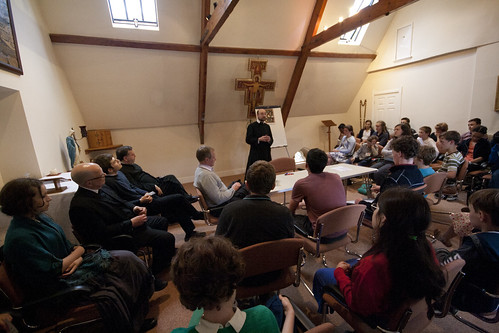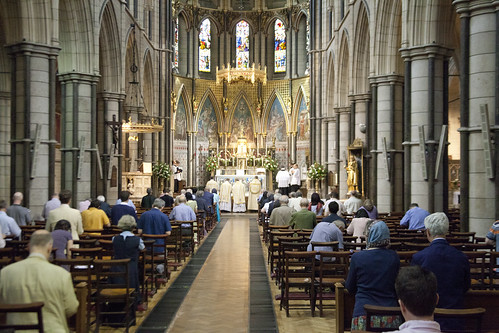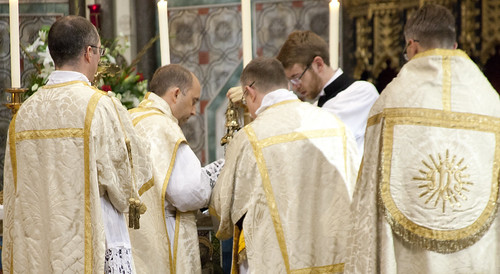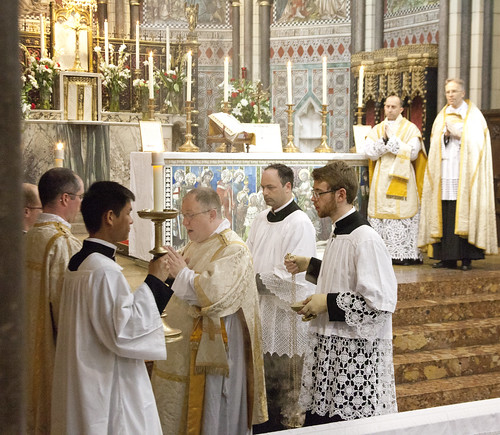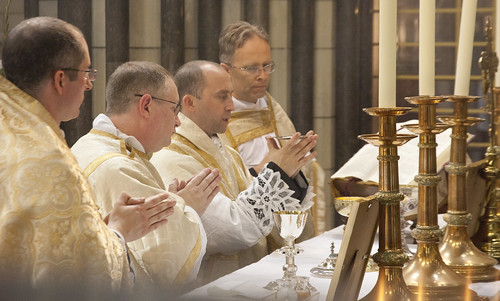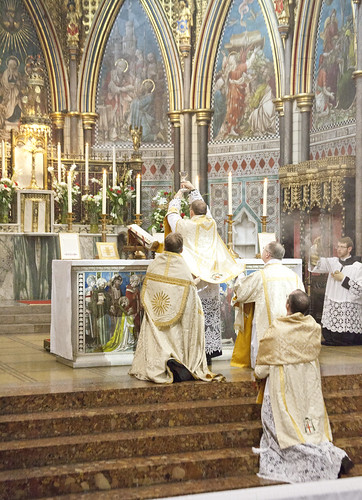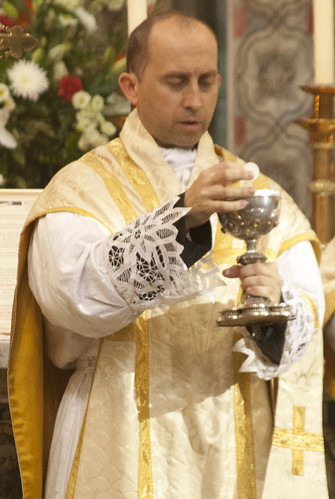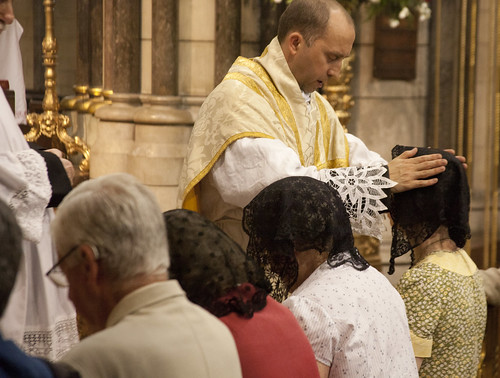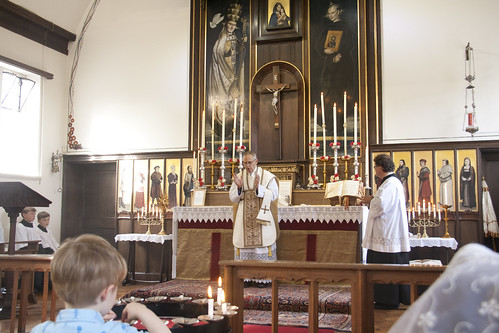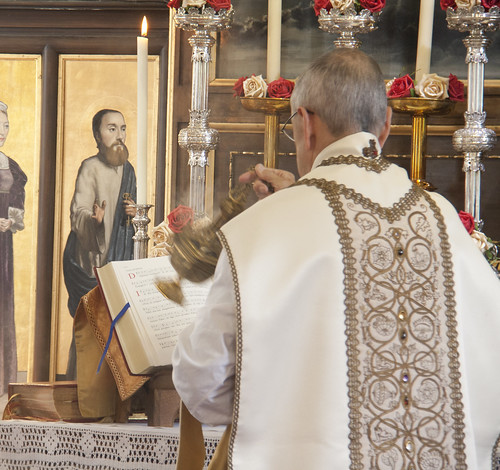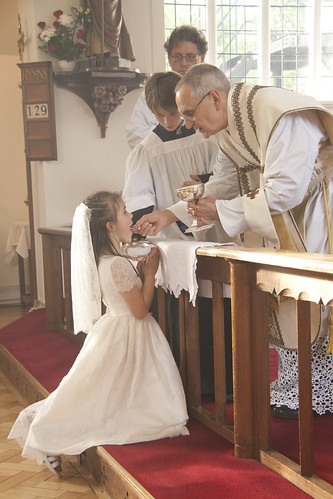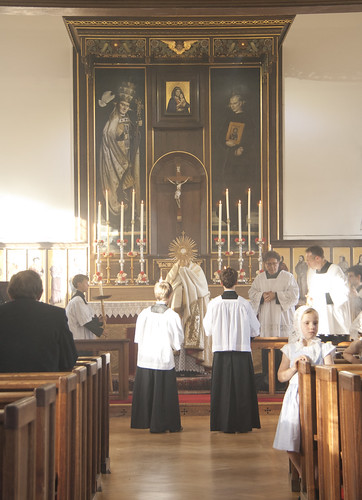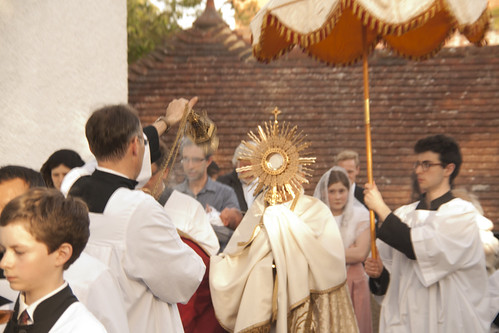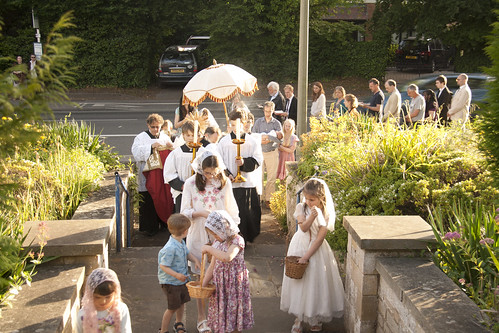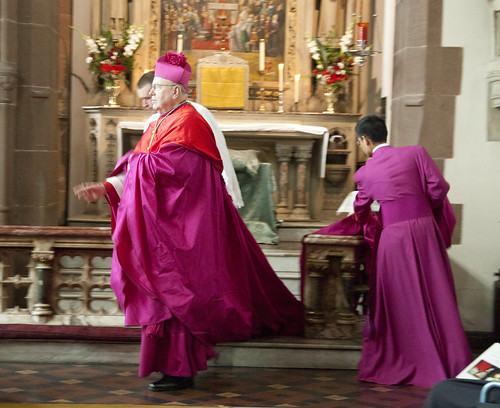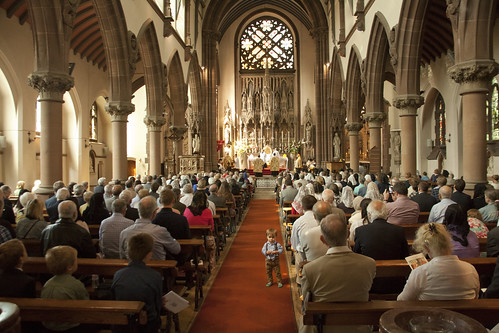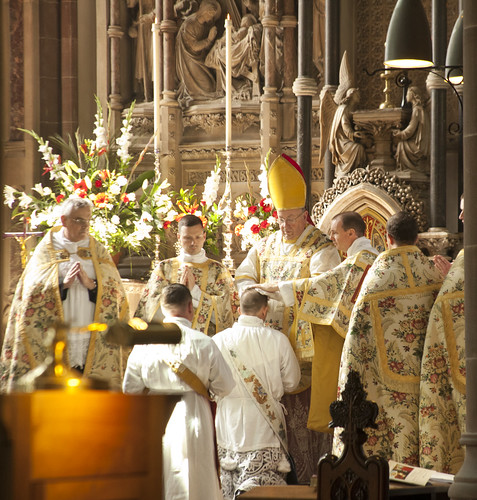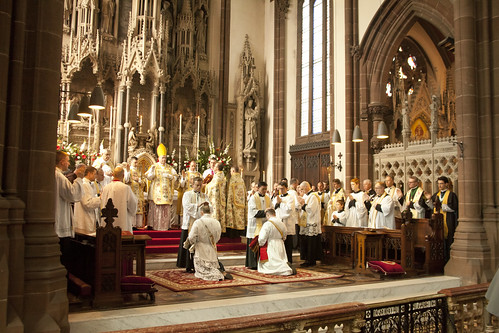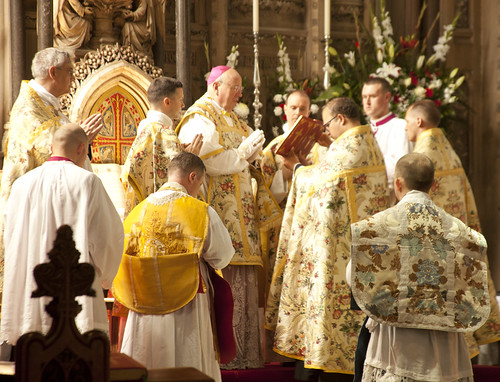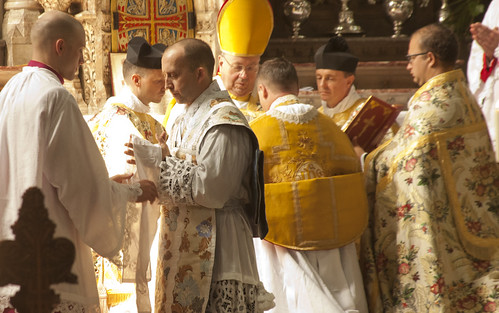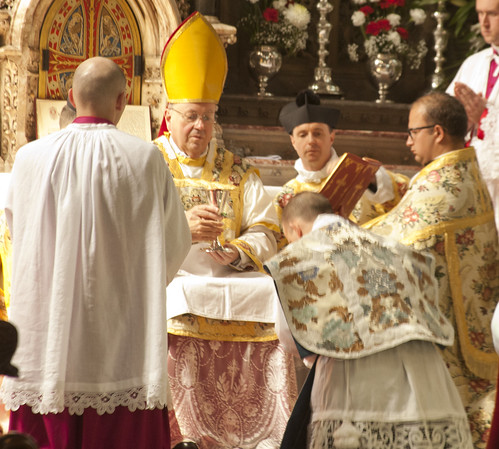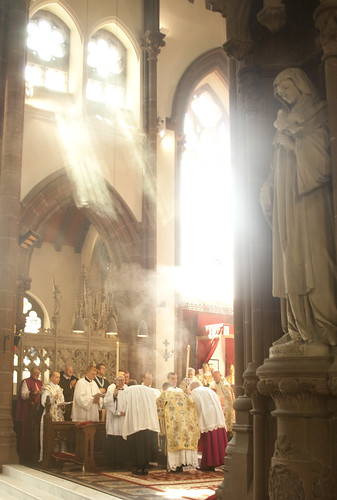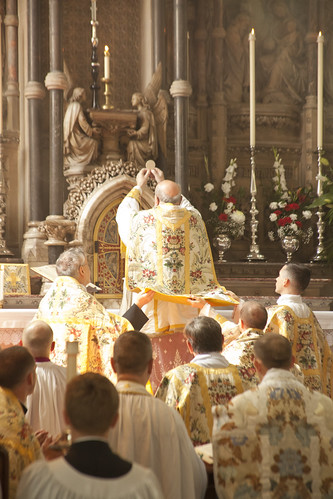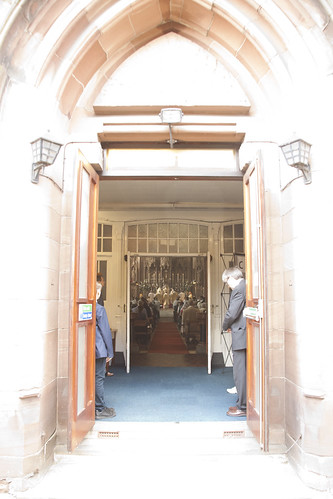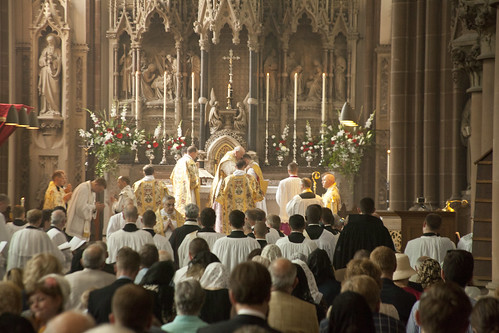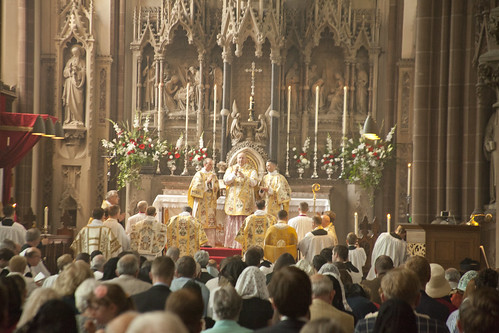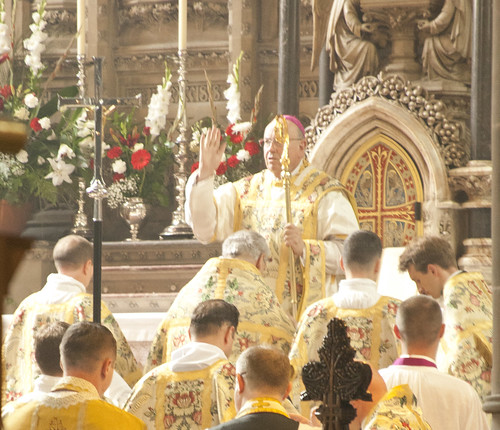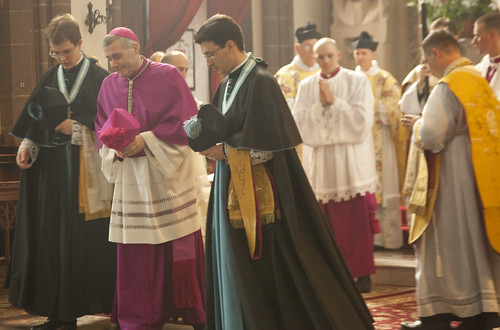Chairman's Blog
Institute of Christ the King given another church in Preston, England
Here is the press release.
-------------------------------------------
The historic and landmark (Grade II Listed) Catholic Church of St Thomas of Canterbury & the
English Martyrs on Garstang Road, Preston (known simply as English Martyrs) has been given a
promise of a sustainable future following an announcement made today by the Bishop of
Lancaster, the Rt Rev Michael G Campbell OSA.
Bishop Michael Campbell and Monsignor Gilles Wach, Prior General of the Institute of Christ the
King Sovereign Priest, together with Rector, Canon Adrian Towers, have agreed that, as from the
autumn, the Institute will assume the administration of the church.
This move will enable the church to be open each day to become a vibrant shrine of devotion to
and promotion of the English Martyrs under the care of the Institute who already have the
administration of St Walburge’s Shrine Church, Weston Street, Preston. The new shrine will
specifically provide for the celebration of Holy Mass and the other Sacraments in the extraordinary
form of the Roman Rite.
English Martyrs’ Church is one of two church buildings belonging to St John XXIII Parish, Preston
– the other being St Joseph’s on Skeffington Road. As part of the arrangement with the Institute,
English Martyrs church remains part of St John XXIII Parish and a priest from there will celebrate
an English-language ordinary form Mass in the church, at least for the next 12 months, each
Saturday evening.
Recently, the Mass attendance at English Martyrs has averaged around 70 people and activities
and voluntary parish involvement have become somewhat limited making it difficult for the
parishioners to shoulder their responsibility for the care of the church building.
Bishop Campbell upon making this announcement commented:
“We are very grateful for the Institute of Christ the King Sovereign Priest and the dedication they
have to evangelizing through use of the extraordinary form,” Bishop Campbell continued “The
Institute has shown tremendous energy in conveying a sense of the sacred through their proven
ministry at St Walburge’s and around the world. We are especially encouraged that their care and
ministry in large and historic churches may also be instrumental in preserving English Martyrs
church now and going forward.”
Canon Amaury Montjean for the Institute added:
“We are deeply grateful to Bishop Campbell for his gracious invitation. Our entire Institute family is
very glad for this new apostolate at English Martyrs. Like St Walburge’s, it will be a unique spiritual
home offering Masses with sacred music, daily confessions, days of recollection, classes in
spirituality and doctrine etc”.
Bishop Campbell concluded:
“Finally and importantly, the announcement of this initiative will ensure the future sustainability and
patrimony of English Martyrs’ church; a building so dear to local Catholics and many others in
Preston. Thankfully, this announcement means English Martyrs is saved from the prospect of
closure and is thus secured for the future. The fact that the church will be used each day for prayer
and cared for by the Institute means it will continue to witness to the faith and mission of the
Catholic Church in Preston for many years to come.”
STATEMENT ENDS
Notes to Editors:
The English Martyrs’ Church is located near to Preston city centre and stands on the
corner of the A6 (Garstang Road), between Aqueduct Street and St George's Road.
English Martyrs Church is built on the site of an area that used to be called Gallows Hill. It
received that name after the Battle of Preston of the Jacobite rising of 1715. After the
government overcame the rebel army, it was on Gallows Hill that the rebel prisoners were
executed. On the 5 January 1715, it was recorded that sixteen rebels 'were hanged upon
Gallows Hill, for high treason and conspiracy.'
The Institute of Christ the King Sovereign Priest is based internationally in Florence,
Italy. In many cases, the Institute’s ministry has revitalized and allowed for the restoration
of historic churches. The Institute was established canonically in 1990 by Monsignor Gilles
Wach and Father Phillipe Mora. Inspired by their patron, St Francis de Sales, the Institute
strives to form its people in holiness according to their motto of "teaching the truth with
charity".
In September 2014, the Institute assumed the care of St Walburge’s Church, Preston, at
Bishop Campbell’s invitation – the Bishop designating the Church as a shrine church.
Support the work of the LMS by becoming an 'Anniversary Supporter'.
The problem of catechising children with popular culture
This comment on the American Protestant phenomenon of 'Vacation Bible Schools' is superb, and applicable to attempts to use popular culture in the catechising of children in Catholic contexts too. The post is here.
These programs are written and produced by Christians with good intentions, but the baseline bait n’ switch philosophy is perverse, like trying to get your child to eat vegetables by embedding them in a Twinkie. Sure, the child will hear some good things about God, but the medium of the message—the razzle-dazzle theme, characterless music, throwaway crafts, forced theatrics, the theological minimalism—is what the child internalizes.
The deeper message conveyed is that what is meant to be an eternal truth is derivative, unserious, inauthentic, forgettable, commercial, frivolous, and cheap. Based on the evidence, millennials figured out how to nibble at the bait and leave the hook bare.
To speak generally, the medium of the message becomes its own catechesis, catechizing children in the forms of pop culture. The shallow entertainment value of attention-grabbing imagery and soundtracks keeps the soul bopping around from thought to thought, preventing any sort of serious reflective thinking. Yes, even four-year-olds are capable of reflective thinking!
The author, Peter Burfeind, doesn't do so well with proposing a solution: his idea seems to be simply to offer children a better version of the same thing. I am involved in a Catholic Summer School, admittedly for older children than he seems to have in mind, and our solution is something completely different: an introduction to Catholic culture and the Catholic intellectual tradition, the public prayer of the Church in their traditional forms, and the Sacraments. It's not so very difficult, really.
Support the work of the LMS by becoming an 'Anniversary Supporter'.
Damien Ashby RIP
A long-serving Latin Mass Society Representative and activist, Damien Ashby, has died.
Details of his funeral:
Requiem aeternam dona ei, Domine, et lux perpetua luceat ei. Requiescat in pace.
Support the work of the LMS by becoming an 'Anniversary Supporter'.
A curious attack on the 'four Cardinals'
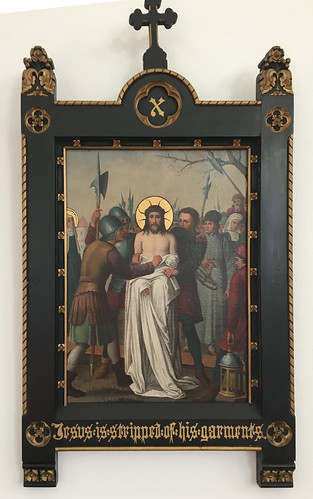 A certain Stephen Walford has written two blog posts at Vatican Insider criticising the stance of the four Cardinals who have asked Pope Francis for a clarification of the teaching of Amoris laetitia.
A certain Stephen Walford has written two blog posts at Vatican Insider criticising the stance of the four Cardinals who have asked Pope Francis for a clarification of the teaching of Amoris laetitia.
It is difficult to criticise a request for clarification: as Cardinal Pell put it, How can you disagree with a question? The opposition, some of it quite embittered, to the Cardinals' request reminds me of the advice given to Sir Gawain by his mother in his quest for the Holy Grail. 'Don't ask questions', she said: but it was only by the asking of a question, the seeking of the meaning of the strange vision he witnessed in the Grail castle, that the curse could be lifted. Have we come so far, as a Church, that questions are forbidden? Are we, the children of the Church, to be reduced to silence? Did Vatican II usher in an era of - what was that phrase? - dumb spectators? Does the old clericalist motto of 'pay, pray, and obey' now apply not just to the laity but to the most senior clergy in the Church?
The first of Walford pieces is about how we should accept the teaching of Amoris laetitia on the basis of the teaching of previous popes on the subject of Papal authority. He correctly points out that the Ordinary Magisterium can be infallible - infallible teaching is not limited to 'extraordinary' pronouncements such as the anathema of General Councils and solemn ex cathedra statements by Popes. He also, correctly, notes that not everything Popes say counts as Magisterial at all, let alone infallible: indeed they can teach error (he mentions Pope John XXII's sermons against the Particular Judgement). When this happens we say, obviously, that what they taught was not the teaching of the Church, but the Pope's 'private' views.
These observations, however, do not get us very far in assessing the alleged teaching of Amoris laetitia since pointing out that papal pronouncemnents can fit in anywhere on a spectrum between obligatory to believe and obligatory not to believe does not, on its own, tell us where on the spectrum these particular pronouncments sit. Walford gives his readers absolutely no assistance in working this out. It is obvious, however, that where we cannot use the form of teaching to help us determine whether it is magisterial or not (i.e., it is not expressed as the anathema of a General Council or a solemn ex cathedra decree), then we have to look at the content.
Thus, when Pope St John Paul II taught in Evangelium vitae that abortion is intrinsically evil (it can never rightly be done: no motive or circumstance can justify it), he prefaced it in a special, solemn way, but more importantly he connected it with the sources of the content of the Faith. (Section 57.)
Therefore, by the authority which Christ conferred upon Peter and his Successors, and in communion with the Bishops of the Catholic Church, I confirm that the direct and voluntary killing of an innocent human being is always gravely immoral. This doctrine, based upon that unwritten law which man, in the light of reason, finds in his own heart (cf. Rom 2:14-15), is reaffirmed by Sacred Scripture, transmitted by the Tradition of the Church and taught by the ordinary and universal Magisterium.
This teaching of Pope St John Paul is infallible by the Ordinary Magisterium, because it comes out of the Ordinary Magisterium. It the Pope's special charism to interpret this teaching authoritatively, but not to change it. It was entrusted to the Church by Christ. The idea that the Ordinary Magisterium is in the business of undertaking doctrinal 'backflips' (in another phrase of Cardinal Pell) is simply incoherent. If we see in the history of the Church uncertainty and disagreement on some point, that is an indication that the Ordinary Magisterium has not determined the issue. As with the Immaculate Conception, the most the Ordinary Magisterium was able to say was that the doctrine was favoured. It took an act of the Extraordinary Magisterium to make its acceptance by all Catholics obligatory, because when Catholics looked to the Ordinary Magisterium, over the centuries, they did not see a clear teaching.
In this way, Walford's impassioned references to teachings about the authority of the Pope and the Ordinary Magisterium miss the point. With the controversial things allegedly deriving from Amoris we don't get as far as being able to say that it is part of the Ordinary Magisterium or in any way part of the Papal Magisterium in the strict sense, becuase it is not clear what the teaching is, and on the kind of understanding of it Walford proposes, it is far from clear that it is consistent with the Ordinary Magisterium. You can't appeal to the authority of the Ordinary Magisterium to destroy the authority of the Ordinary Magisterium. At this point Walford appears to have disappeared into a theological house of mirrors, where the teaching of the Popes on the authority of the Ordinary Magisterium makes the actual Ordinary Magisterium on the subject of adultery disappear.
The second of Walford's pieces takes the form of an appeal to the Four Cardinals to 'reconsider'. He asserts that in various ways Pope Francis has already answered the questions they asked. The first of the dubia, which asked if those living in illicit unions as if married can be absolved and given communion, can be dismissed:
It seems that in relation to the first dubia, you have trouble accepting the two authentic interventions of Pope Francis in which he has already affirmed that in certain cases, sacramental discipline has been changed: firstly, in answer to Francis Rocca’s question on the flight from Lesvos to Rome on April 16, 2016, and secondly, on September 5, 2016, when he praised the Argentine Bishops’ draft guidelines stating there is: “no other interpretation” of Amoris Laetitia Ch. 8.
This is really glorious. The first 'authentic intervention' was an off-the-cuff answer to a journalist on an aeroplane; the second 'authentic intervention' was a private letter which was leaked to the press. Neither of them, obviously, will find its way into the Acta Apostolicis Sedis, the official record of Papal acts. Is this some kind of joke? Is this how Walford thinks that matters of fundamental importance are decided? He's pulling our legs here, surely?
But suppose for a mad moment that in Walford-land the Pope reserves his most solemn pronouncements for journalists in informal question-and-answer sessions, and letters which are not actually promulgated to the Faithful: why is the Holy Father reluctant to put this same answer into a letter to the Four Cardinals? Why is he so reluctant to answer this question to their faces that he has taken to cancelling his meetings with the College of Cardinals? Why not slip it into some official document? Indeed, why not make Amoris clear in the first place? Walford must realise that there is an answer to this question too.
What of the other dubia? On these Walford takes the opposite strategy. Instead of saying that the Pope in hints and winks has made it perfectly clear that a momentous change has taken place, he proposes that various bits of boiler-plate phrasing in Amoris itself is suffient to show that no change has taken place at all.
Here Walford seems to have missed the point of all the controvery since the document came out, and indeed of the meaning of the term ambiguity. The confusion has arisen from the fact that while some phrases in the document appear to reiterate the traditional position, other phrases seem to indicate something quite different. Being able to quote the former is absolutely pointless if you don't have a convincing explanation of the latter. Walford appears to recognise that he is unequal to the challenge, so he does not even attempt to explain them.
The passages which cause difficulty are helpfully listed by the 'Appeal to the Cardinals' of the '45 academics' (of whom I was one): see it here, thanks to 1Peter5. The claim of the Appeal was not that these passages cannot be read in a way compatible with the teaching of the Church, but that people were not always reading them in that way and that these other readings were leading them astray. In this situation what we need is an authoritative clarification. The Four Cardinals are asking for the same thing for the same reason. If the boiler-plate passages had been enough to stop these bad readings, then they would have done so; since they have not, more is needed.
This seems a simple enough line of argument, but Walford appears to inhabit an parallel universe in which the only problems being caused by Amoris are being caused by theological conservatives. If only the Cardinals, and their supporters, would pipe down, everything would be fine. It really wouldn't take much searching to find Catholics using Amoris to contradict those things which Walford claims Amoris preserves, which he lists as follows:
1) The teachings on the indissolubility of marriage remains
2) Each person must strive to follow the moral teachings of the Church
3) Divorce is an evil, and adultery is always evil—even if guilt can be reduced or erased altogether
4) Consciences must be formed. Nowhere does the text allow anyone to come to the conclusion they can do as they please
5) In no way does Pope Francis suggest that irregular unions are a “good” alternative option to the original marriage. However, it cannot be denied that grace is at work in some of these unions
We don't need to start citing Fr James Martin SJ and Mgr Basil Loftus, however. For the fundamental problem with Walford's position is that the one issue he does think Amoris changes itself contradicts these claims.
As already noted, in his view the Pope's answer to the first dubium is in the affirmative: Can those living in illicit unions as if married can be absolved and given communion? Yes. But, Walford claims, while this is a change, it is only a change to discipline, not doctrine. (One wonders, then, why in his first article he needed to emphasise so much Pope Francis' authority over dogma, if dogma hasn't changed at all.)
Here Walford is sadly mistaken. It is impossible for a priest to give absolution and Holy Communion to a person who is publicly living an adulterous life and - we should add - is not in some psychlogical state which undermines his moral agency or makes him unable to comprehend the moral law. If marriage is indissoluble (Walford's first point of unchanged doctrine), and if we are obliged to keep the moral law (a truism, but Walford's second point), and if adultery is always an evil (Walford's number three), then it follows that a penitent who knows he is committing adultery and fails to repent of it, cannot be absolved. Furthermore, if by public civil marriage his situation is well known to priest and people, the priest cannot give him Holy Communion.
The second point is a matter of the discipline of Canon Law, Walford may say: but as a matter of fact the Canon Law has not been changed, so if Walford thinks that there is no possible confusion here, he needs to explain why the Pope is asking priests to break Canon Law when he could change it. It may be that the Pope hesistates simply to abolish the relevant Canons because as many have pointed out these Canons simply reiterate Divine Law, and for all his plenitude of power the Pope can't change that.
This should be even clearer on the first point, the case of Confession. Walford talks about a change to the 'marriage discipline', but his claim about what Amoris means carries over, by his admission, to the conditions under which a priest may give sacramental absolution. Can the Pope change these conditions? In certain ways: he can 'reserve' certain sins so they can only be absolved by the bishop or by the Holy See, for example. But can he make it possible for a priest validly to absolve a penitant of a mortal sin which the penitent does not repent?
This suggestion is so insane that I do not believe that Walford can have this in mind. But the only alternative appears to be to say that by some secret decree Pope Francis has brought it about that adultery is not an 'evil' after all: instead of re-writing the conditions for a valid absolution, we would then be in the business of re-writing the Ten Commandments. And that is insane as well.
This, Mr Walford, is why the Four Cardinals are pressing the Holy Father for an answer. The common interpretations of Amoris, including those which appear to have Pope Francis' favour, lead to theological impossibilities. To refuse their right to ask this question is to condemn each and every Catholic to padded cell.
Support the work of the LMS by becoming an 'Anniversary Supporter'.
New Book: Noble Beauty, Transcendent Holiness, by Peter Kwasniewski
Noble Beauty, Transcendent Holiness
Why the Modern Age Needs the Mass of Ages
PETER KWASNIEWSKI
 Foreword by Martin Mosebach
Foreword by Martin Mosebach
I've provided a blurb for this book; here it is in full below. Buy the book here.
Peter Kwasniewski's tremendous new book is an eloquent and erudite confrontation with the very root of the liturgical debate: whether the radical de-mystifying of the Catholic liturgy has been for the good of souls. It is not a matter of personal preferences, the evolving needs of 'modern man', or even of the reverence of the celebrating priest. It is rather of the truth or falsity of the massive testimony of the liturgical tradition, which is the testimony of the Church herself, that the kind of liturgy which pleases God, softens the hearts of sinners, and raises the pious towards sancticy, is the mysterious product of centuries of development. When a functionalist liturgist rejects ceremonies and language whose meaning is not immediately clear, he rejects precisely the vehicles which can carry the full weight of the Faith, something which cannot be expressed in a common-place formula. Only something whose meaning cannot be exhaustively expounded by the liturgists of today, will have insights for the Catholics of tomorrow, and of every age.
Josep Shaw, Chairman of the Latin Mass Society, England
Buy the book here.
LMS AGM Mass with Fr Alex Stewart FSSP: photos
Fr Alex Stewart, ordained only a week, celebrated a High Mass in St James' Spanish Place in London for the LMS Annual General Meeting.
Support the work of the LMS by becoming an 'Anniversary Supporter'.
Corpus Christi and a First Holy Communion in Oxford: photos
Support the work of the LMS by becoming an 'Anniversary Supporter'.
Ordinations in Warrington: Photos
Holy Orders was conferred, and Mass celebrated, by Archbishop Malcolm McMahon OP, in St Mary's Church, Warrington. The ordinands were Alex Stewart, FSSP and Krzysztof Sanetra, FSSP. Bishop Mark Davies of Shrewsbury was in choir.
Support the work of the LMS by becoming an 'Anniversary Supporter'.
A computer game based on Plato?
I know nothing about computer games, but no doubt some of my readers do, and may be interested in this Kickstarter funding campaign to create a game based on Plato's Critias - the one about the lost island of Atlantis.
This is a fantasy 'quest', based not on the Hollywood nonsense-history of Lara Croft and company, but on the profound and intriguing myth-history of Plato's Critias. Perhaps many historians today would like to turn the more eccentric corners of their studies into a computer-game, but the creators of 'The Unwritten Critias' have the technical virtuosity actually to do this.
Juventutem Mass in London Friday 23rd
With the newly ordained Fr Alex Stewart FSSP, in St Mary Moorfields, London EC2M 7LS
7:30pm, Friday 23rd June
Support the work of the LMS by becoming an 'Anniversary Supporter'.

